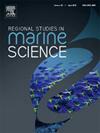Bioaccumulation of natural radionuclides in edible molluscs and associated risk from the Ashtamudi Estuary, situated in a high background natural radiation zone (HBNRA), Kerala, southwest coast of India
IF 2.1
4区 环境科学与生态学
Q3 ECOLOGY
引用次数: 0
Abstract
The study investigated various natural radionuclides, including 238U, 232Th, 210Po, and 210Pb, in edible molluscan species collected from different zones of the Ashtamudi estuary. Physicochemical and sedimentological factors played crucial roles in influencing the distribution of radionuclides in water and sediments. Notably, bivalve species, particularly those from the Cyrenidae family, exhibited significant bioaccumulation of 210Po (up to 432.8 Bq kg−1) and 210Pb (up to 121.3 Bq kg−1), with Zone VI recording the highest biological concentration factor (BCF) and biological sediment accumulation factor (BSAF). The calculated effective dose for humans consuming bivalve meat was moderate, falling above the lower end of the ICRP range of 1 mSv y−1 but well below the upper limit of 20 mSv y−1 for existing elevated radiation zones. The intake of radioactivity from some bivalves corresponded to a cancer risk of approximately 3.2 × 10−2 (total mortality + morbidity), exceeding the acceptable risk threshold reported by the USEPA. However, this level of exposure indicated that immediate action might not be necessary, especially if further dose reduction proved impractical, in line with the ICRP's approach to optimizing radiation protection.
印度西南海岸喀拉拉邦高本底天然辐射区(HBNRA)阿什塔穆迪河口可食用软体动物体内天然放射性核素的生物累积及相关风险
研究调查了从阿什塔穆迪河口不同区域采集的可食用软体动物物种体内的各种天然放射性核素,包括 238U、232Th、210Po 和 210Pb。物理化学和沉积物因素在影响放射性核素在水和沉积物中的分布方面发挥了关键作用。值得注意的是,双壳贝类,尤其是鲤科双壳贝类,对 210Po(高达 432.8 Bq kg-1)和 210Pb(高达 121.3 Bq kg-1)表现出显著的生物累积性,其中第六区的生物浓缩系数(BCF)和生物沉积物累积系数(BSAF)最高。计算得出的人类食用双壳贝肉的有效剂量适中,高于国际放射防护委员会 1 mSv y-1 的下限,但远低于现有高辐射区 20 mSv y-1 的上限。从一些双壳贝类摄入的放射性相当于约 3.2 × 10-2 的癌症风险(总死亡率 + 发病率),超过了美国环保局报告的可接受风险阈值。不过,这一辐照水平表明,可能没有必要立即采取行动,特别是在进一步减少剂量证明不切实际的情况下,这符合国际辐射防护委员会优化辐射防护的方法。
本文章由计算机程序翻译,如有差异,请以英文原文为准。
求助全文
约1分钟内获得全文
求助全文
来源期刊

Regional Studies in Marine Science
Agricultural and Biological Sciences-Ecology, Evolution, Behavior and Systematics
CiteScore
3.90
自引率
4.80%
发文量
336
审稿时长
69 days
期刊介绍:
REGIONAL STUDIES IN MARINE SCIENCE will publish scientifically sound papers on regional aspects of maritime and marine resources in estuaries, coastal zones, continental shelf, the seas and oceans.
 求助内容:
求助内容: 应助结果提醒方式:
应助结果提醒方式:


